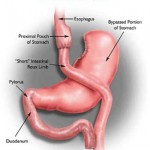Laparoscopic Conversion from Gastric Banding to Roux-en-Y Gastric Bypass
Wednesday, November 12, 2008 Earlier this week, I blogged about the rather frequent occurence (upto 30%) of band and port complications seen with laparoscopic adjustable gastric banding (LABG). I also mentioned that other complications of this surgically simple procedure, like band migration, pouch-enlargement, esophageal dilation, or port-site infections, can require reoperation or conversion to roux-en-Y gastric bypass (RYGB).
Earlier this week, I blogged about the rather frequent occurence (upto 30%) of band and port complications seen with laparoscopic adjustable gastric banding (LABG). I also mentioned that other complications of this surgically simple procedure, like band migration, pouch-enlargement, esophageal dilation, or port-site infections, can require reoperation or conversion to roux-en-Y gastric bypass (RYGB).
Fortunately, this conversion can be done laparoscopically with a high rate of success.
That, at least, is the gist of a report by Langer and colleagues from the Medical University of Vienna, Austria, in this month’s issue of Obesity Surgery, who addressed the poor long-term outcome in a growing number of LABG patients, due to primary inadequate weight loss or secondary weight regain.
The aim of this study was to prospectively assess the safety and efficacy of laparoscopic conversion to Roux-en-Y gastric bypass (RYGBP) in 25 patients, who failed LABG due to inadequate weight loss (n = 10) or uncontrollable weight regain (n = 15).
All procedures were completed laparoscopically within a mean duration of 219 +/- 52 (135-375) min with no significant complications. This shows that revisional surgery, while possible, takes significantly longer than a primary RYGBP (which generally takes around 90 mins).
Following conversion to RYGBP, mean body weight was reduced by 14%, 18% and 24% at 3, 6, and 12 months, respectively. No statistically significant differences were found comparing weight loss within these two groups.
Thus, while this study shows that it is technically possible to convert failed LABG to RYGBP with good results, it also reemphasizes the fact that a significant number of LABG patients will fail in the long-term and will need reoperation.
Although, LABG remains a simple and relatively successful bariatric option in the short term, all patients planning to undergo LABG should be warned of the relatively high long-term failure rates of this procedure and should be given the option of undergoing RYGBP as a primary intervention. All bariatric surgical centres should offer both procedures to their patients and be prepared to convert failed LABGs to RYGBPs.
AMS
Edmonton, Alberta


